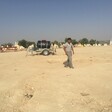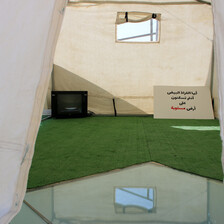The Electronic Intifada Gilboa Prison 4 March 2011

Al-Araqib village (ActiveStills)
Al-Araqib was the last village I visited before my arrest. Al-Araqib is not just a village, but the very heart of a nation and a people. On 5 May 2010, I was there under the tent of Sheikh Sayah, a local leader. There was a big crowd after the destruction and the reconstruction of the village. We met there until late at night, taking advantage of the desert darkness.
Al-Araqib is a small village in the southern part of historic Palestine known as al-Naqab but which Israel calls the “Negev.” Since mid-2010, Israel has bulldozed the village more than a dozen times.
We had come at the request of Sheikh Raed Salah but especially in answer to the call of our duty and our responsibility as a nation. Before the evening gathering of the activists in al-Araqib, we had visited the village of Houra where we met activist Nouri al-Uqbi, then Liqyeh and activist Alayan Sane. Our delegation from the Popular Committee for the Defense of Political Freedoms, in the framework of the High Follow up Committee for the Arab Citizens of Israel, included Abdel Hakim Moufid, Raja Aghbariyeh, Qadri Abu Wassel, lawyer Abd al-Raouf Mouassi and myself. Forgive me if I have left anyone out.
This was my last visit before police and security forces raided my home and arrested me one hour after I arrived back in Haifa after midnight. I can no longer follow the evolution of events except for the biased information available here in prison.
At that meeting in al-Araqib, we knew that the eyes of the Israeli forces of uprooting were upon us under the convenient cover of the desert, hiding their criminal face and hands in its darkness. Just as the saying goes, that the “people of Mecca know their territory better than anyone else,” so the people of al-Araqib know their territory and its night-time environment better than anyone. However, the uprooters have usurped the friendly obscurity of the desert. They invade the land and the night, bringing with them injustice, blackness, uprooting, expulsion and forced exile. The Zionist project has cast this darkness throughout its history.
The darkness of the plan has cast its dark shadow over al-Araqib, the Naqab, the Galilee, the coast, the Triangle, Jerusalem, Gaza, West Bank and has travelled across the ocean, preventing the light of liberty from reaching Gaza, besieging it. The darkness has stretched out over those in exile in a vain attempt to hide the homeland, cut it off from light and hope, hidden from the option of return.
But the people in our homeland know what they are doing and know who is watching them. They know their right to their homeland as well as the rights due to them inside it.
Neither the Israeli eyes watching us nor the bulldozers of destruction and ethnic cleansing can change our minds. They have been active every minute for six decades. But we, the masses of the people inside, have been growing in strength every day since the Nakba — the ethnic cleansing of historic Palestine in 1947-48 — and during the ongoing Nakba. We have become stronger in our resistance to oppression and the system of ethnic cleansing, and our will has broken free.
At the meeting in al-Araqib, we prepared an emergency plan of action and confrontation to resist and hold our ground. We divided up the tasks and shared our concerns while planning how to face the imminent destruction with our bodies by mobilizing people backed by efficient local and international solidarity. We determined that every single house destroyed would be rebuilt and every single tent torn down set up again, no matter what the price. The reconstruction would take place immediately after such crimes of destruction. Our visit was not the beginning of our existential struggle. It was a planned additional step to gain momentum in the knowledge that it is a decisive battle, not a local problem, but a strategic stand. The battle for al-Araqib is a fundamental event in defense of the nation and what is left of the land in order to protect Arab existence in the Naqab and to recuperate as much stolen land as possible. This is a battle for our homeland, a test of our willpower and an expression of the direction our popular struggle has taken over several decades.
If we see this battle as just one more incident, we will deliver al-Araqib and all it represents into their hands. We cannot. Al-Araqib is an integral part of the nation at a key moment when national duty and the spirit of defiance and steadfastness call upon the people to resist, bearing in mind the initial battle for land and home, on 30 March 1976: Land Day.
On that day, Israeli forces killed six Palestinian citizens of Israel protesting against a government decision to confiscate thousands of dunams of their land in the Galilee. Palestinians everywhere annually commemorate Land Day as a protest against Israel’s discriminatory policies towards its 1.2 million Palestinian citizens and to underline their collective and individual rights.
Today, we face a plan for ethnic cleansing from the same system, of the same nature, but focusing on al-Araqib.
There is an intimate link between popular resistance in al-Araqib and in Sheikh Jarrah, Silwan, Nilin, Bilin, in the Triangle and in al-Rawha, the fight against house demolition and Judaization in the Galilee, the fight for Umm Sahali and all the struggles of The Association of the Forty of Ein Hod and the Regional Council of Unrecognized Villages in the Naqab, Nuri al-Uqbi’s fight for the defense of his land and his right to live on it, the Palestinian and international movement against the blockade of Gaza, the fight to preserve the Arab character of Jerusalem and its holy sites and other popular resistance movements.
The energy of these struggles, born of grassroots and local solidarity movements and taken up by international supporters, is growing every minute. This solidarity constitutes a powerful force of dissuasion against those invading al-Araqib and elsewhere and acts as a protection for the people of this country and its landowners whether living here at the moment or refugees from here.
It is important to realize that Israel has now understood that the Arab peoples are a strategic force of which, at this stage, the Palestinians are the best organized. They are able to defend their rights, their existence and all the rights due to their people. They are as capable of recuperating rights they have been denied, such as their national inheritance and their land, as they are of waging legal battles, where our position is much stronger than Israel’s. The system intent on uprooting al-Araqib, like the entire process of uprooting and expulsion, must be ever vigilant to justify its legitimacy, while we in turn need to question its legitimacy every day in order to put a halt to all its illegal actions.
This system will stop at no crime unless we challenge its every move. The dynamics of this confrontation prove that neither al-Araqib nor its population needs any recognition from its oppressors and uprooters since the land and its history acknowledges their presence: the nation knows its own people and their legitimacy derives from this unbreakable tie.
All honor to the High Follow up Committee for the Arab Citizens of Israel for making the correct connection between the Jerusalem/al-Quds and al-Aqsa uprisings in 2000 and the fight for al-Araqib and the defense of the homeland by calling for major action in the Naqab and on the land of al-Araqib in the Naqab on the eve of Land Day. They send a message to us and to the world that our cause is indivisible, that our people stand united for our cause.
Ameer Makhoul is a Palestinian civil society leader in Israel and currently in Gilboa prison. This edited essay was translated from Arabic to French by Rim al-Khatib and from French to English by Carol Scheller.




